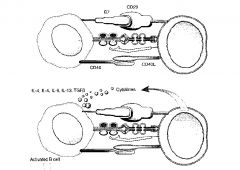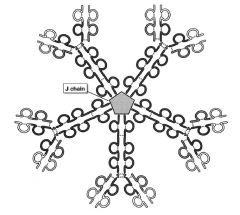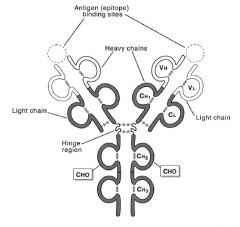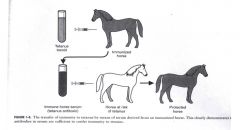![]()
![]()
![]()
Use LEFT and RIGHT arrow keys to navigate between flashcards;
Use UP and DOWN arrow keys to flip the card;
H to show hint;
A reads text to speech;
13 Cards in this Set
- Front
- Back
|
How do we perform isotype switching?
|

-after antigen cross-links receptors on the B cell, the material is endocytosed and processed via the endocytic (exogenous) pathyway to generate MHC class II peptide conjugates, which are then inserted in the membrane
-simultaneously expression of costimulatory molecules such as B7 is upregulated on the B lymphocyte making them effective presenters of antigen to TH cells in the area -once a TH recognizes a processed antigenic peptide displayed with MHC II the two cells form a conjugate and the TH cell is activated and induced to become a TH2 cell -TH2 cells in conjugates rearrange their Golgi apparatus toward the junction with the B cell leading to the directional release of cytokines toward the B cell -in addition, expression of a molecule known as CD40L on the surface of the TH2 cell is upregulated, and this molecule interacts with CD40 on B cells to provide the second signal for B cell activation -the final signal delivered by the TH2 cell is the release of cytokines which will induce the differentiation of B cells into fully differentiated antibody secreting cells and memory cells, and induce class switching |
|
|
What are the key antibody functions?
|
✤Neutralization:
-binding of antibodies to toxins or viruses stops their binding and attachment ✤Opsonization: -focus immune cells to pathogens via antibody binding to Fc receptors on macrophages, neutrophils, eosinophils, and NK cells -leads to destruction of the pathogen by phagocytosis or cytotoxic lysis (NK cells) ✤Complement activation: -lysis of pathogens -C3b produced (opsonin) -triggers inflammatory responses |
|
|
What does IgM do?
|

Exists in 2 forms:
-a monomer is synthesized and retained on the membrane of B cells -plasma IgM exists as a pentamer -J-chain joins the monomer units -avidity is the highest of all the isotypes -affinity may be low -functions in trapping free antigen -earliest antibody to appear after antigenic stimulation, fixes complement and (indirectly) leads to the death of cells with which they bind -the pentameric nature of IgM also facilitates agglutination |
|
|
What does IgG do?
|

-IgG is the major antibody produced after IgM
-IgG exists in 4 isotypes -IgG activates complement, opsonises and mediates ADCC -bind Fcγ receptor on phagocytic cells |
|
|
What does IgA do?
|

-most IgA is produced in the submucosa
-IL-5 and TGF-β cause isotype switching to IgA -IgA is a dimer with a J chain -IgA inhibits binding of adhesive substances to mucosal surfaces -found in tears, saliva, mucus & milk SECRETION: -as the IgA dimer is produced by plasma cells and B lymphocytes, it becomes bound to receptors on the abdominal side of the epithelia, is endocytosed, and is released into the lumen wearing a secretory piece that is the residue of the epithelial receptor -the secretory component thus serves an important function in transepithelial transport, and once in the lumen of the tract, has a function in protecting the molecule from proteolytic cleavage |
|
|
What does IgE do?
|

-IL-4 and IL-13 cause isotype switching to IgE
-IgE is bound to mast cells and basophils -IgE mediates immediate type I allergic reactions -IgE protects against parasites -it attaches to mast cells receptors: FcεR |
|
|
In which species is there passive transfer of maternal antibodies?
|

✤Primates - haemochorial placenta - IgG transferred
-mothers blood is in contact with endothelium, and IgG can transfer ✤Dogs & Cats - endotheliochorial placents - 5-10% of IgG transferred ✤Ruminants - syndesmochorial placenta - No transfer -get Ab after first milk ✤Horses & pigs - epitheliochorial placenta - No transfer -get Ab after first milk -in animals where there is no placental transfer of maternal Ab, newborn animals are totally dependent upon colostrum for passive transfer of maternal immunoglobulins -significant amounts of IgM, IgG, and IgA can be found in colostrum and maximal absorption occurs in the first 24 hours after birth |
|
|
How does passive immunization work & what do we use it for?
|

-used for toxins ie. tetanus cause by Clostridium tetanii
-a common bacterium, Costridium tetanii, when it infects through superficial wounds can cause a disease called tetanus -the disease process (which can be lethal) is mediated by a toxin molecule which acts quickly – more quickly than the immune system can elicit antibodies. -intravenous injection of anti-toxin serum into an affected subject (provided this is done soon enough) is highly protective -donor antibodies attach to the tetanus toxin (an exotoxin which is neurotoxic) and promote its blockage & destruction -these donor antibodies are made in horses by injecting a chemically inactivated toxin (toxoid) molecule which elicits antibodies capable of binding active toxin -removal of Ig from the donor serum eliminates its protective activity -snake bite anti-venoms are important example of passive immunization |
|
|
What characterizes the secondary immune response?
|

✤A much faster reaction time (secondary response starts at 1-3 days and peaks at 3-5 days, as opposed to starting at 4-7 days and peaking at 7-10 days)
✤A higher antibody response (typically 2-3 order of magnitude) ✤A qualitatively different antibody response (ie. different isotypes, generally more IgG) ✤Secondary responses require T cell help while primary response can occur independent of T cells ✤A higher affinity of the antibodies to the antigen -the pathogen is eliminated more rapidly |
|
|
What is the principle behind most vaccines?
|
-RELY ON IMMUNE MEMORY
-during the first exposure to the antigen when the animal is vaccinaed a primary immune response is induced -because the vaccine is either attenuated (ie. made less pathogenic) or inert there will be only a mild or no disease associated with the vaccination -during this vaccination a typical primary immune response is induced with the production of IgM antibodies and most importantly the generation of memory T & B cells -these memory cells are long lived and can last several years and up to the entire life of the animal -when the vaccinated animal gets infected, sometimes many years later, the memory T & B cells get activated resulting in a rapid high affinity immune response with the production of large amounts of IgG |
|
|
What is an example of a vaccine that does not rely on immune memory?
|
✤CATTLE TICKS:
-cattle ticks transmit diseases (Theileria sp. and Babesia sp.) and are present in tropical areas including for example Queensland -to fight these diseases it is possible to vaccinate the animals with a vaccine containing a tick gut antigen -the antibodies against this antigen are ingested during feeding of the ticks on cattle blood -the antibodies interact with the gut of the tick reducing their development and killing them -because the ticks never enter the host, the immune system of cattle is not normally exposed to gut antigens -thus the vaccine relies on the presence of existing antibodies -since antibodies in circulation only last a couple of months it is essential to revaccinate the animals regularly so that antibody levels are maintained above the level required for protection |
|
|
What are the characteristics of immune memory?
|
-lasts for a long time, often for the life of the animal (vs. primary which lasts only several months and in some species even shorter)
-memory B cells are generated in the lymph node and remain there for several weeks before they recirculate in the body via efferent lymph -upon interaction with antigen B cells get activated -provided the right signals are present they can undergo class switch and affinity maturation -some B cells will differentiate to plasma B cells producing large amounts of antibodies and migrating to the spleen and bone marrow while other will become memory B cells -memory B cells can express different surface Ig and recirculate in the body going from blood to tissues and/or lymph -they also have a higher affinity to the antigen & a longer lifespan |
|
|
What is an example of a pathogen that has been able to avoid attack by immune memory?
|
Trypanosomes have the ability to change the surface antigen so that after each wave of parasites a new variant emerges against which the antibodies generated during the previous wave are ineffective
-difficult to vaccinate cattle against this disease |

